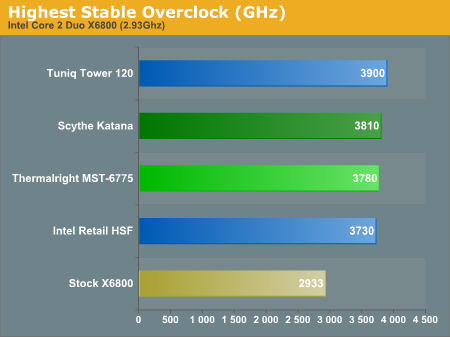Value Cooling: Two Towers for under $30
by Wesley Fink on January 23, 2007 3:50 AM EST- Posted in
- Cases/Cooling/PSUs
Overclocking
When cooling solutions do a better job of keeping the CPU at a lower temperature, it is reasonable to expect the overclocking capabilities of the CPU will increase. In each test of a cooler we measure the highest stable overclock of our standard X6800 processor under the following conditions:
Memory is set to Auto timings on the 680i and memory speed is linked to the FSB for the overclocking tests. This removes memory as any kind of impediment to the maximum stable overclock. Linked settings on the 680i are a 1066FSB to a DDR2 memory speed of DDR2-800. As FSB is raised the linked memory speed increases in proportion. The same processor is used in all cooling tests to ensure comparable results.

Both the Thermalright MST-9775 and the Scythe Katana enable higher overclocks than the stock Intel cooler. Neither of the coolers under test, however, comes close to the overclocking performance of the Tuniq Tower 120. Where the stock cooler reached 3.73GHz with this CPU, the Thermalright extends this to 3.78GHz, the Scythe Katana allows a stable 3.81GHz, and the same processor reached a stable 3.90GHz with the Tuniq Tower.
When cooling solutions do a better job of keeping the CPU at a lower temperature, it is reasonable to expect the overclocking capabilities of the CPU will increase. In each test of a cooler we measure the highest stable overclock of our standard X6800 processor under the following conditions:
CPU Multiplier: 14x (Stock 11x)
CPU voltage: 1.5875V
FSB Voltage: 1.30V
Memory Voltage: 2.20V
nForce SPP Voltage: 1.5V
nForce MCP Voltage: 1.7V
HT nForce SPP <-> MCP: Auto
Memory is set to Auto timings on the 680i and memory speed is linked to the FSB for the overclocking tests. This removes memory as any kind of impediment to the maximum stable overclock. Linked settings on the 680i are a 1066FSB to a DDR2 memory speed of DDR2-800. As FSB is raised the linked memory speed increases in proportion. The same processor is used in all cooling tests to ensure comparable results.

Both the Thermalright MST-9775 and the Scythe Katana enable higher overclocks than the stock Intel cooler. Neither of the coolers under test, however, comes close to the overclocking performance of the Tuniq Tower 120. Where the stock cooler reached 3.73GHz with this CPU, the Thermalright extends this to 3.78GHz, the Scythe Katana allows a stable 3.81GHz, and the same processor reached a stable 3.90GHz with the Tuniq Tower.










28 Comments
View All Comments
orangesky - Tuesday, January 23, 2007 - link
Since the Thermalright fan blows down towards the motherboard (as does Intel's stock HSF), but the Katana blows across (and out of the case), it seems like there would be a noticable air flow difference on the components around the CPU (e.g., VRM, memory, and NB).Was there any difference noted in the temperature of the "motherboard" (which probably is the NB)? I'm wondering if this is a concern or not, especially for OC'ing?
Spacecomber - Tuesday, January 23, 2007 - link
For coolers, like the Katana, which lack 4-wire connectors that 775 motherboards can automatically adjust fan speeds via, perhaps it would be helpful to take advantage of speedfan for comparing cooling across a range of fan speeds. (This is assuming that the relatively new 680i motherboard that you are using is supported by SpeedFan.)Doh! - Tuesday, January 23, 2007 - link
A new version of Katana has a 4-wire connector. I just bought one last week. The box has 775 written on it and does not come with a back plate.Wesley Fink - Tuesday, January 23, 2007 - link
Scythe has introduced another version of the Katana called the Katana 775. This was to address the installation and fan speed issues we discussed. The Katana 775 only fits Socket 775 and it comes with a 4-pin fan header. The original Katana, with universal installation as we reviewed here, continues as a current product.If you are only concerned with Socket 775 the Scythe Katana 775 looks lik a much better choice with easier installation and fan speed control at the same price or less than the original Katana.
KorruptioN - Tuesday, January 23, 2007 - link
For under $30, I think the Arctic Cooling Freezer 7 Pro should've been included. Quiet, not so heavy, with very good performance for the money.Wesley Fink - Tuesday, January 23, 2007 - link
We are not finished with coolers under $30, and we will try to include the Arctic Cooling Freezer 7 Pro in our upcoming value cooler roundup. The Freezer 7 Pro also uses a 92mm fan, but it weighs a bit more than this pair at 520g (vs. 300g and 420g).mostlyprudent - Tuesday, January 23, 2007 - link
I notice in the noise charts that the Retail HSF is only listed once. Is this at its idle speed? I may have missed it in the review, but what is the RPM range of the retail HSF?BTW, nice article.
Wesley Fink - Tuesday, January 23, 2007 - link
The Intel Retail HSF was below the system noise floor at both high and low speeds. We will try to make this clearer in future reviews.